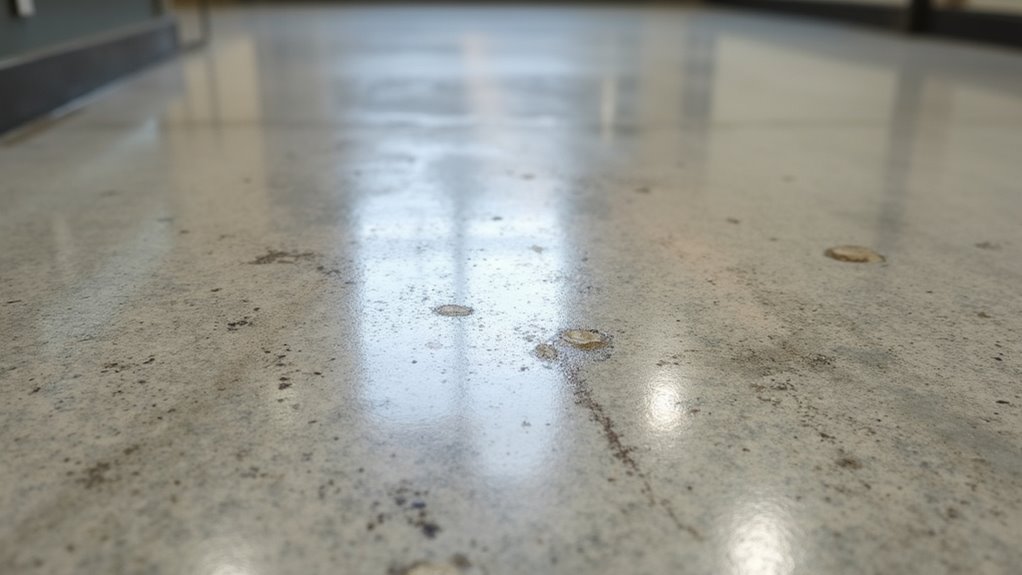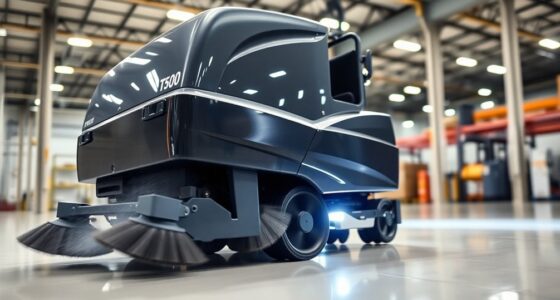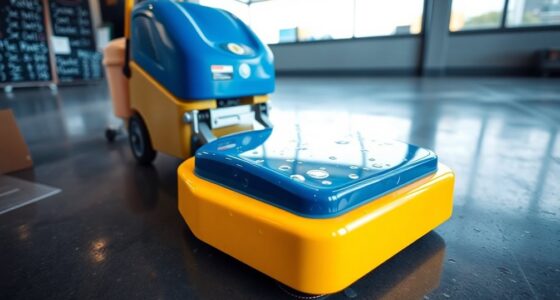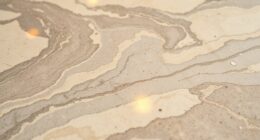One common mistake is choosing improper scrubbers that can scratch or dull polished concrete; always select equipment with soft brushes or pads suitable for delicate surfaces. Neglecting routine maintenance, like inspecting and replacing worn pads, leads to damage over time. Using harsh cleaning solutions or excessive water can also harm the finish. To keep your floors looking their best, make certain your equipment is appropriate and well-maintained—stay tuned to learn simple fixes that prevent costly mistakes.
Key Takeaways
- Using aggressive scrubbers or incompatible brushes can scratch or dull polished concrete surfaces; switch to softer pads and compatible equipment.
- Neglecting regular inspection and replacement of scrubber pads leads to ineffective cleaning and potential surface damage; replace worn pads promptly.
- Applying harsh or alkaline cleaning solutions can dull the finish; use pH-neutral cleaners formulated for polished concrete.
- Overusing water or excessive scrubbing causes streaks and puddles; adjust machine settings and use appropriate cleaning techniques.
- Skipping routine maintenance and inspections increases the risk of equipment malfunction and surface deterioration; establish consistent maintenance routines.

Polished concrete floors require careful maintenance, but common scrubber mistakes can easily damage their smooth surface. One of the biggest errors you might make is using improper equipment selection. Not all scrubbers are created equal, and choosing the wrong type can lead to unnecessary wear or even surface damage. For polished concrete, you need equipment designed specifically for delicate surfaces. Heavy-duty scrubbers with aggressive brushes or pads can scratch or dull the finish, so it’s vital to select machines with softer brushes or pads that are compatible with polished surfaces. Additionally, make certain that the scrubber’s brush rotation and pressure settings are adjustable. This allows you to customize the cleaning process and avoid applying excessive force that could harm the concrete’s gloss. Skipping this step or using generic equipment can cause long-term deterioration, so take the time to research and invest in the right tools.
Maintaining a consistent maintenance routine is equally important. Many overlook this aspect, thinking occasional cleaning suffices. However, irregular or improper routines can quickly lead to surface degradation. A proper maintenance routine involves regular sweeping to remove dirt and debris that can scratch the surface when scrubbed. It also includes choosing the right cleaning solutions—pH-neutral cleaners are best for polished concrete, as they clean effectively without stripping away the surface’s natural sheen. Using harsh or overly alkaline cleaners can dull the finish and create buildup that becomes harder to remove over time. When you follow a disciplined routine, including scheduled deep cleans and regular inspections, you help preserve the floor’s integrity. Incorporating proper cleaning solutions can further enhance your maintenance efforts and protect the surface from damage.
Another mistake involves neglecting to clean or replace scrubber pads and brushes regularly. Worn-out pads lose their effectiveness and can scratch or mar the polished surface. Make it a habit to inspect your equipment before each use and replace pads that are frayed, worn, or no longer clean. This simple step prevents damage and ensures your cleaning process remains efficient. Additionally, you should calibrate your scrubber’s settings for each task. Excessive water or overly aggressive scrubbing can leave streaks or puddles, which may cause uneven wear or dull spots on the floor. Proper equipment selection and maintenance routines are essential—they work together to keep your polished concrete looking pristine and protected from damage caused by common mistakes.
Frequently Asked Questions
Can Using the Wrong Scrubber Damage Polished Concrete Surfaces?
Yes, using the wrong scrubber can damage polished concrete surfaces. If you choose abrasive pads or apply improper pressure, you risk scratching or dulling the finish. Make sure to select the appropriate pad for polished concrete and use gentle, consistent pressure. Avoid excessive force, as it can cause surface etching or uneven wear. Proper equipment and technique protect your surface’s shine and longevity.
How Often Should Polished Concrete Floors Be Scrubbed?
You should scrub polished concrete floors only when necessary, typically once every few months or as needed for stain prevention. Over-scrubbing can damage the surface, so guarantee proper floor sealing to protect against stains and wear. Use gentle cleaning techniques and avoid harsh chemicals. Regular maintenance helps preserve the shine, prevents stains, and keeps your floors looking their best without risking damage from excessive scrubbing.
Are There Specific Cleaning Solutions Best for Polished Concrete?
Think of cleaning polished concrete like tending a delicate garden; using the right tools matters. The appropriate cleaning solutions for polished concrete are pH-neutral cleaners and safe chemical options that won’t dull the shine. Avoid harsh acids or bleach, which can damage the surface. Always check labels, and test a small area first. This approach keeps your floors gleaming and avoids costly repairs, just like nurturing a healthy garden.
What Are Signs of Over-Scrubbing Polished Concrete?
If you over-scrub polished concrete, you’ll notice a dulling of its sheen and possible surface etching. You might see uneven patches or a loss of that smooth, reflective finish. Over-scrubbing can also cause micro-scratches that diminish the surface’s clarity. To avoid this, use gentle cleaning methods and avoid excessive pressure. Regular maintenance with proper techniques helps preserve the polished concrete’s original shine and prevents damage.
Does the Type of Scrubber Affect the Floor’s Finish?
Choosing the right scrubber directly impacts your floor’s finish, so pick a suitable scrubber that matches your polished concrete’s characteristics. A compatible scrubber guarantees thorough cleaning without damaging the surface, preserves the floor finish, and prevents dullness or scratches. Always consider factors like pad type, brush pressure, and cleaning solution compatibility. When you select a suitable scrubber designed for your floor’s specific needs, you protect its shine and extend its lifespan.
Conclusion
By avoiding these common scrubber mistakes, you can keep your polished concrete looking its best. Remember, regular maintenance extends your surface’s lifespan—studies show that properly maintained floors can last up to 50% longer. So, take the time to spot and fix issues early on. With just a few simple adjustments, you’ll prevent costly damage and enjoy a stunning, durable finish for years to come. Your polished concrete will thank you!









